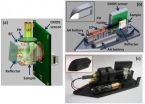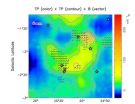(Press-News.org) ANN ARBOR, Mich. — It's not how old but how frail patients are that can predict how well they will fare after a melanoma diagnosis. In fact, young patients in poor health may have worse outcomes than older patients in good shape.
A new study from the University of Michigan Comprehensive Cancer Center finds that patients with decreased core muscle density were more likely to see their cancer spread to distant parts of the body.
These findings may also support the idea that the patient's biological response to a tumor is important in controlling the spread of melanoma. Patients whose systems are less able to mount a response may be more prone to their cancer spreading.
The researchers believe that identifying those patients who are at higher risk of poor outcomes could impact treatment decisions, including the success of new immunotherapy drugs. And potentially, if this degenerative muscle loss, called sarcopenia, can be reversed, patients might have better outcomes.
The study, which appears online in Annals of Surgical Oncology, looked at 101 patients treated for stage III melanoma at the U-M Comprehensive Cancer Center. Researchers examined CT scans for each patient to measure the area and density of a core muscle called the psoas, which runs along both sides of the spine.
They found that patients with lower muscle density had significantly higher rates of their cancer returning – regardless of factors such as the size of the tumor or the patient's age. Every 10 units of decreased muscle density translated to a 28 percent increase in recurrence. In addition, frailer patients had more complications from surgery to remove their cancerous lymph nodes.
Research has previously linked older age to worse outcomes in melanoma. These new results distinguish that it's the underlying vitality of the patient, not age, that really matters.
Many studies have looked at ways to reverse sarcopenia by focusing on diet and exercise.
"The big question is if we could reverse sarcopenia through better nutrition and exercise, would that lead to a decreased risk of recurrence in those patients?" says lead study author Michael S. Sabel, M.D., associate professor of surgery at the U-M Medical School.
In addition, researchers hope this information will help explain the limited success of new immunotherapy or cancer vaccine treatments.
"The data suggests that frailer patients may be less likely to respond to these forms of therapy. It is very possible that prior trials of vaccines or other immune therapies that didn't show an effect would have shown an effect if we had weeded out the patients unlikely to respond to therapy," Sabel says.
Researchers plan next to look at CT scans from patients treated in these trials to analyze whether the treatments were more effective in patients without sarcopenia.
Melanoma statistics: 68,130 Americans will be diagnosed with melanoma this year and 8,700 will die from the disease, according to the American Cancer Society
###Additional authors: Jay Lee; Shijie Cai, Ph.D.; Michael J. Englesbe, M.D.; Stephen Holcombe, M.S.; and Stewart Wang, M.D., Ph.D., all from U-M
Reference: Annals of Surgical Oncology, DOI: 10.1245/s10434-011-1976-9; published online Aug. 6, 2011. "Sarcopenia as a Prognostic Factor among Patients with Stage III Melanoma"
Resources:
U-M Cancer AnswerLine, 800-865-1125
U-M Comprehensive Cancer Center, www.mcancer.org
Clinical trials at U-M, www.UMClinicalStudies.org
Patients' underlying health linked to worse outcomes for melanoma, U-M study finds
2011-08-31
ELSE PRESS RELEASES FROM THIS DATE:
Mother-son ties change over time, influence teen boys' behavior, Wayne State study finds
2011-08-31
DETROIT – Relationships between mothers and their sons change during childhood and adolescence, however, not all relationships change in the same way. A Wayne State University-led study has found that how the relationships change may affect boys' behavior when they become teens.
The research team, led by Christopher Trentacosta, Ph.D., assistant professor of psychology in the College of Liberal Arts and Sciences at Wayne State University, looked at 265 mother-son pairs from low-income families in Pittsburgh, starting when the boys were 5 through adolescence. The families ...
Localizing language in the brain
2011-08-31
CAMBRIDGE, Mass. -- New research from MIT suggests that there are parts of our brain dedicated to language and only language, a finding that marks a major advance in the search for brain regions specialized for sophisticated mental functions.
Functional specificity, as it's known to cognitive scientists, refers to the idea that discrete parts of the brain handle distinct tasks. Scientists have long known that functional specificity exists in certain domains: In the motor system, for example, there is one patch of neurons that controls the fingers of your left hand, and ...
Role of soy in menopausal health reported
2011-08-31
Soy has recently been reviewed and supported for introduction into general medical practice as a treatment for distressing vasomotor symptoms of menopause, such as hot flashes, but its use in other medical areas, such as heart health, requires further research, according to a new report reviewing the risks and benefits of soy protein, isoflavones and metabolites in menopausal health from The North American Menopause Society (NAMS)/Wulf H. Utian Translational Science Symposium, published in the July Menopause, the peer-reviewed NAMS journal.
"Although a significant amount ...
Microscope on the go: Cheap, portable, dual-mode microscope uses holograms, not lenses
2011-08-31
WASHINGTON, Aug. 30—To serve remote areas of the world, doctors, nurses and field workers need equipment that is portable, versatile, and relatively inexpensive. Now researchers at the University of California at Los Angeles (UCLA) have built a compact, light-weight, dual-mode microscope that uses holograms instead of lenses. The team describes the new device in a paper published today in the Optical Society's (OSA) open-access journal Biomedical Optics Express.
Their prototype weighs about as much as a medium-sized banana and fits in the palm of a hand. And, since it ...
IU analysis changing diagnosis and management of initial UTIs in young children
2011-08-31
INDIANAPOLIS – Analysis by Indiana University School of Medicine researchers of ten years of scientific studies has resulted in changes in American Academy of Pediatrics recommendations for how initial urinary tract infection in infants and toddlers is diagnosed and treated. This change will affect thousands of children every year.
The findings of the IU School of Medicine investigators argue against exposing all young children who are diagnosed with an initial urinary tract infection (UTI) to a painful radiologic test and against prescribing prophylactic antibiotic treatment ...
The Great Recession could reduce school achievement for children of unemployed
2011-08-31
The Great Recession could have lingering impacts on the children of the unemployed, according to researchers at the University of Chicago.
"There is growing evidence that parental job loss has adverse consequences on children's behavior, academic achievement and later employment outcomes, particularly in economically disadvantaged families," said Heather Hill, assistant professor in the University of Chicago School of Social Service Administration. The material hardship and stress associated with unemployment appears to reduce the quality of the home environment and ...
Future climate change may increase asthma attacks in children
2011-08-31
Mount Sinai School of Medicine researchers have found that climate change may lead to more asthma-related health problems in children, and more emergency room (ER) visits in the next decade.
The data, published in the current issue of the American Journal of Preventive Medicine, found that changing levels of ozone could lead to a 7.3 percent increase in asthma-related emergency room visits by children, ages 0-17.
The research team, led by Perry Sheffield, MD, Assistant Professor of Preventive Medicine at Mount Sinai School of Medicine, used regional and atmospheric ...
Beyond pills: Cardiologists examine alternatives to halt high blood pressure
2011-08-31
More and more, patients show up to appointments with hypertension expert John Bisognano, M.D., Ph.D. carrying bags full of "natural" products that they hope will help lower their blood pressure. And like most physicians, Bisognano doesn't always know if these products will do any good, or if they will cause any harm.
"Right now we're seeing a cultural shift where an increasing number of people want to avoid standard pharmaceuticals," said Bisognano, professor of Medicine and director of Outpatient Cardiology at the University of Rochester Medical Center. "We're also ...
More questions than answers remain concerning effects of airplane travel on insulin pump delivery
2011-08-31
New Rochelle, NY, August 30, 2011—Despite recent concerns that changes in atmospheric pressure during airplane travel may affect the amount of insulin delivered via pump devices, the current evidence is limited and it would be unwise to overreact until more data are available, according to an insightful editorial in Diabetes Technology & Therapeutics, a peer-reviewed journal published by Mary Ann Liebert, Inc. The editorial is available free online.
Irl B. Hirsch, MD, Professor of Medicine, University of Washington School of Medicine (Seattle), and Senior Editor of Diabetes ...
An atlas of the Milky Way
2011-08-31
This press release is available in German.
It may not be much use to hitchhikers through the galaxy, but it is extremely valuable to astronomers: the new radio atlas of the Milky Way. After almost ten years of work, researchers at the Max Planck Society and the Chinese Academy of Sciences have completed their investigation into the polarised radio emission in the galactic plane. The atlas is based on observations undertaken with the 25-metre radio telescope in the Chinese city of Urumqi and shows an area of 2,200 square degrees of the sky.
The radio survey covers ...



